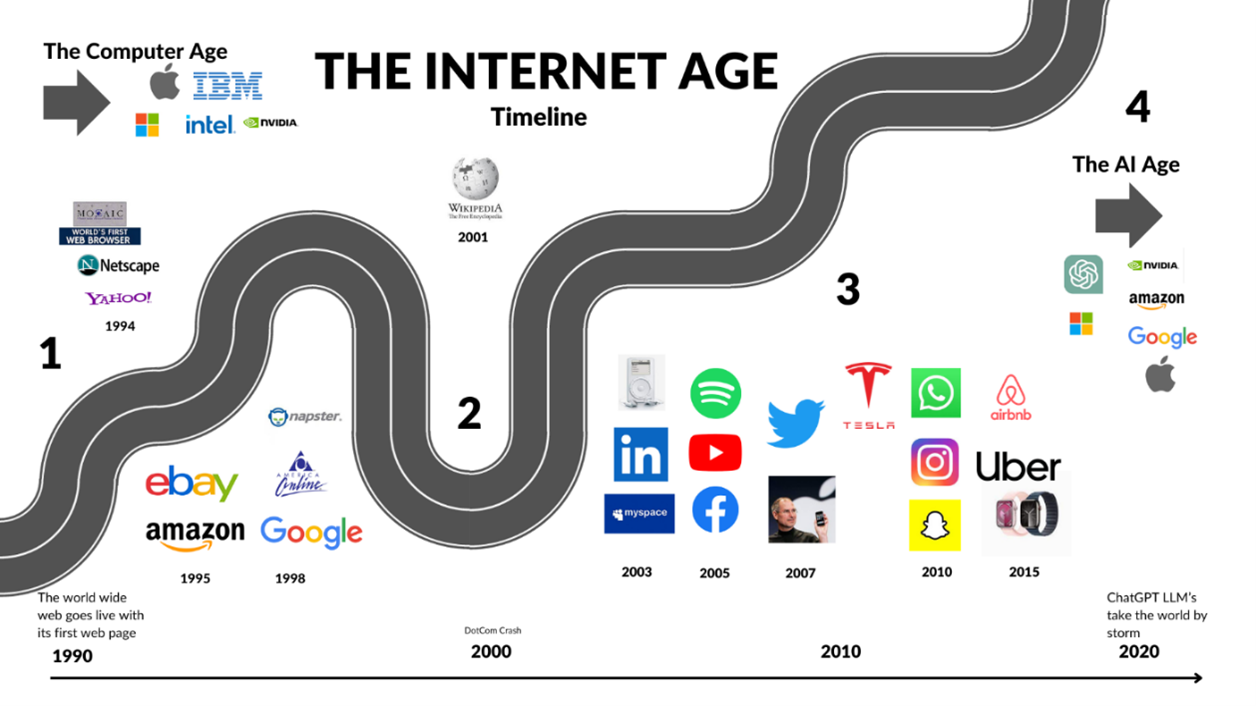AI in 2025 is what the Internet was in 1999

Back in 1999, the internet was an emerging phenomenon poised to reshape the global economy. Web-based companies were popping up almost daily, and adventurous entrepreneurs saw the writing on the wall: the internet was not just a fad—it was the future. Fast forward to 2025, and we find ourselves at a similar inflection point with Artificial Intelligence (AI). The same sense of untapped potential and transformative power that characterized the internet in its early days now permeates the world of AI.
The Parallels Between AI in 2025 and the Internet in 1999
- Exponential Growth: In 1999, the internet user base grew at staggering rates. Similarly, AI models are proliferating and improving in capability at an unprecedented pace. The continual refinement of machine learning algorithms and increases in computational power are driving hyper-growth in AI adoption.
- New Business Models: Remember how e-commerce, digital advertising, and online media changed the landscape in the early 2000s? AI is now doing the same, enabling entirely new business models—from personalized AI-driven healthcare to autonomous robots delivering groceries.
- Massive Infrastructure Needs: Just as the dot-com era demanded new infrastructure (broadband, servers, global connectivity), AI demands specialized hardware (GPUs, TPUs, advanced cloud services) and robust data pipelines to handle its ever-growing computing needs.
- Emerging Standards and Regulatory Frameworks: Much like the early web’s “Wild West” era before regulations caught up, AI standards and policies are still being formulated. This creates both uncertainty and opportunity for businesses able to navigate these evolving landscapes.
Areas Worth Investing in the World of AI Agents
There are numerous articles and tweets (Xs) predicting that 2025 will be the year of AI Agents. Here are ChatGPT o1 predictions for areas worth investing in 2025:
- Generative AI for Content Creation
- Why It Matters: Large Language Models (LLMs) are revolutionizing how businesses automate writing, design, and even coding tasks. These generative models are enabling new tools for bloggers, marketers, and software developers alike.
- Potential Opportunities: AI-driven copywriting platforms, automated marketing suites, and creative design tools.
- Healthcare and Life Sciences
- Why It Matters: From AI-assisted diagnostics to drug discovery, intelligent systems can process vast amounts of data more efficiently than humans, speeding up medical breakthroughs and improving patient outcomes. I wrote more about this in my previous blog post Unlocking the Future: How GenAI is Set to Revolutionize Healthcare and Education .
- Potential Opportunities: AI-based diagnostic imaging, predictive analytics for patient care, drug discovery platforms, and precision medicine.
- Personalized Education and Training
- Why It Matters: The era of 1 teacher in the classroom teaching the same thing at the same pace for different kids is over. The pandemic highlighted the importance of flexible and effective e-learning solutions. Adaptive learning platforms that leverage AI can tailor course materials to individual needs. I wrote more about this in my previous blog post Unlocking the Future: How GenAI is Set to Revolutionize Healthcare and Education .
- Potential Opportunities: AI tutors, automated grading systems, personalized curriculum design, and educational analytics.
- AI Integration in Robotics and Automation
- Why It Matters: AI-driven robotics can revolutionize manufacturing, supply chain, and logistics. Self-navigating drones, automated warehouse systems, and assistive robots are no longer concepts but realities.
- Potential Opportunities: Autonomous vehicles, industrial robotics, robotic process automation for businesses, and human-robot collaboration software.
- Smart Infrastructure and IoT
- Why It Matters: The Internet of Things (IoT) has grown immensely, but leveraging real-time data streams effectively demands AI’s predictive and analytical muscle.
- Potential Opportunities: Smart city management solutions, energy efficiency tools, predictive maintenance platforms, and consumer-facing IoT devices.
- AI-Powered Cybersecurity
- Why It Matters: As AI proliferates, so do cyber threats. Sophisticated attackers leverage AI to breach systems; robust AI-based defense tools are essential to counter these challenges.
- Potential Opportunities: Next-generation threat detection systems, automated incident response, and AI-driven vulnerability assessment tools.
Looking Ahead
In 1999, countless internet startups failed, while a select few soared to unimaginable heights. A similar phenomenon will play out in 2025 with AI. Not every AI idea will succeed, but the ones that do could shape entire industries and redefine how we live and work.
For investors, entrepreneurs, and tech enthusiasts, the lesson from the dot-com era is clear: do your due diligence but don’t be afraid to place strategic bets on AI. Whether it’s innovative hardware, scalable software platforms, or specialized services, the AI revolution has arrived. Much like the internet did at the dawn of the new millennium, AI is set to generate trillions of dollars in economic value—and change the world in the process.
Just as the internet in 1999 opened a new digital frontier, AI in 2025 is the gateway to a future where machines and humans work together more intelligently, efficiently, and creatively than ever before. Now is the time to jump on board. The next wave of tech disruption is here, and it’s driven by AI.
Happy New Year!